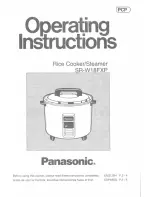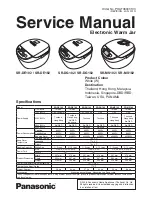
Traditional fruit cakes
It should be remembered that ovens
can vary over time, therefore cooking
times can vary, making it difficult to be
precise when baking fruit cakes.
It is necessary therefore, to test the
cake before removal from the oven.
Use a fine warmed skewer inserted
into the centre of the cake. If the
skewer comes out clean, then the cake
is cooked.
•
Do not attempt to make Christmas
cakes larger than the oven can
cope with, you should allow at
least 25mm (1 inch) space
between the oven walls and the tin.
•
Always follow the temperatures
recommended in the recipe.
•
To protect a very rich fruit cake
during cooking, tie 2 layers of
brown paper around the tin.
•
We recommend that the cake tin is
not stood on layers of brown
paper, as this can hinder effective
circulation of air.
•
Do not use soft tub margarine for
rich fruit cakes, unless specified in
the recipe.
•
Always use the correct size and
shape of tin for the recipe quantities.
Roast turkey
Roasting turkey perfectly can prove
difficult, as you are cooking two
different types of meat - the delicate
light breast meat, which must not be
allowed to dry out, and the darker leg
meat, which takes longer to cook.
The turkey must be roasted long
enough for the legs to cook, so
frequent basting is necessary. The
breast meat can be covered once
browned.
•
Turkey should be roasted at
180˚C for 20 minutes per 1lb,
plus 20 minutes, unless packaging
advises otherwise.
•
The turkey can be open roasted,
breast side down, for half of the
cook time, and then turned over for
the remainder of the cooking time.
•
If the turkey is stuffed, add 5
minutes per 1lb to cook time.
•
If roasting turkey covered with
foil, add 5 minutes per 1lb to
cook time.
To test if the turkey is cooked, push a
fine skewer into the thickest part of the
thigh. If the juices run clear, the turkey
is cooked. If the juices are still pink,
the turkey will need longer cooking.
20
USING THE OVENS
To help the air circulate freely
•
Position the shelves evenly within
the oven and maintain a clearance
from the oven roof and base.
•
If more than one cooking dish or
baking tray is to be used on a shelf,
leave a gap of at least 25mm
between the items themselves and
the oven interior.
•
Allow enough space between
shelves for food that will rise
during cooking.
•
Do not
place items on the oven
base as this will prevent air from
circulating freely.
Baking tray and roasting tins
For best cooked results and even
browning, the maximum size baking
trays and roasting tins that should be
used are as follows;
Baking tray
350mm x 280mm
This size of baking tray will hold up to
16 small cakes.
Roasting tin
370mm x 320mm
We recommend that you use good
quality cookware. Poor quality trays
and tins may warp when heated,
leading to uneven baking results.
Oven shelves & shelf positions
The oven shelf must be positioned with
the upstand at the rear of the oven and
facing up.
Shelf positions in an electric oven are
counted from the bottom of the oven
upwards, so shelf position 1 is the lowest.
When cooking frozen or chilled food,
use the highest possible shelf position,
while allowing some clearance
between the food and the top element
(top oven) / oven roof.
Extra shelves may be ordered from the
Customer Care Centre.
Position baking trays and roasting tins
on the middle of the shelves, and leave
1 clear shelf position between shelves,
to allow for circulation of heat.
Never put items directly on the base of
the oven or cover the oven base with
foil, as this can cause the base element
to overheat.
17
USING THE OVENS


































